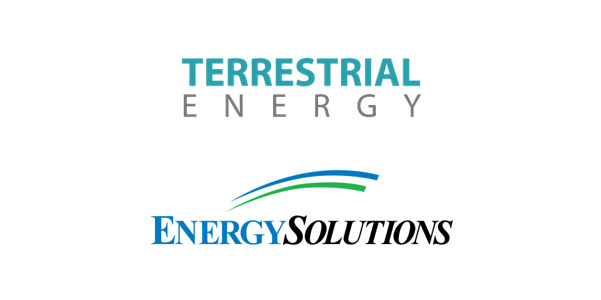Commercial HALEU supply chain draft EIS now open for comment

The Department of Energy yesterday announced a draft environmental impact statement (EIS) on HALEU Availability Program plans to purchase high-assay low-enriched uranium under 10-year contracts to seed the development of a sustainable commercial HALEU supply chain.
“A maximum of 290 [metric tons of] HALEU will be needed to establish a temporary domestic demand for HALEU to stimulate a diverse, domestic commercial supply that would ultimately lead to a competitive HALEU market,” according to a summary of the draft EIS, which analyzes the potential environmental impacts of the activities—from mining and conversion to enrichment, fuel fabrication, transportation, and use—involved in establishing that supply chain. The draft EIS is open for public comment through April 22.
The need: HALEU, enriched between 5 and 20 percent fissile uranium-235, is not currently available from domestic suppliers, and the lack of supply threatens the schedules of the two demonstrations currently funded under the DOE’s Advanced Reactor Demonstration Program: TerraPower’s Natrium and X-energy’s Xe-100. It also has dire implications for the broader deployment of advanced reactors that would use HALEU to fuel smaller, more efficient cores.
“Establishing a secure, domestic HALEU supply is an important step in demonstrating and commercializing advanced nuclear reactors, which are key to meeting the Biden-Harris administration’s clean energy goals by 2035,” said assistant secretary for nuclear energy Kathryn Huff. “Public feedback on the draft EIS will strengthen the process and help ensure we’re considering all the environmental effects of commercial HALEU production.”
From scoping and drafting to final: The DOE issued a notice of intent to fulfill its National Environmental Policy Act (NEPA) obligations for the HALEU Availability Program by launching the scoping process for an EIS in June 2023. That same month, the agency released two draft requests for proposals to acquire HALEU—one covering enrichment services that could include the production of between 5 and 145 metric tons of HALEU during a 10-year performance period, and another for deconverting that HALEU from uranium hexafluoride (UF6) gas to metal or oxide forms in preparation for fuel fabrication.
The final RFP for deconversion services was released in November 2023, and the final RFP for enrichment services was released this January. The latter dropped the maximum delivery of 145 metric tons of HALEU in favor of an indefinite delivery/indefinite quantity contract, and the final enrichment RFP (unlike its draft) would permit some enrichment services (up to 5 percent) to be performed outside the United States by allied nations. That exception aside, both RFPs favor services—from mining and milling to deconversion and storage—provided within the continental United States.
The draft EIS, in brief: Because contracts that may result from those RFPs are still unknown, no specific sites could be analyzed for the draft EIS, which may seem counter to typical objectives. According to the DOE, “The selection of specific locations and facilities will not be a part of the Record of Decision for this EIS. The decisions to be supported are whether or not to acquire HALEU from commercial sources and to facilitate commercial HALEU fuel production capability.” The construction and operation of specific HALEU fuel cycle facilities would be subject to Nuclear Regulatory Commission or Agreement State licensing, and potentially to other federal and state permitting, including a NEPA review.
In the draft EIS, the DOE used NEPA information from existing fuel cycle facilities to estimate potential environmental impacts, and notes that some activities, like mining, milling, and conversion, would be no different from low-enriched uranium fuel cycle activities, while others, such as enrichment and deconversion, are “different but similar,” with “some adjustments [that] need to be implemented to address criticality safety controls for HALEU.” From an environmental impact perspective, according to the DOE’s summary, those adjustments are minor.
The DOE decided—again, because specific sites are not yet known—to “bound” the potential impacts to those associated with “(1) modifications to or expansions of existing uranium fuel cycle facilities, (2) construction and operation of new HALEU facilities at existing industrial facilities/sites (also known as brownfield sites), and (3) construction and operation at undeveloped sites (also known as greenfield sites).” According to the DOE’s summary, constructing and operating modified or new HALEU fuel cycle facilities at existing facilities “results in estimated potential environmental consequences that range from mostly small to moderate,” while those at brownfield and greenfield sites “also could result in estimated potential environmental consequences that range from small to moderate.” Estimated potential impacts for all activities are summarized in a table.
The draft EIS considers impacts from HALEU transportation (to be contracted under the two draft RFPs) and from activities that are not covered under the RFPs but are “reasonably foreseeable actions”: fuel fabrication, HALEU-fueled reactor operation, and used fuel storage and disposition.
Comments requested: Comments on the draft EIS can be sent through April 22 by mail to James Lovejoy, DOE EIS document manager, U.S. Department of Energy, Idaho Operations Office, 1955 Fremont Avenue, MS 1235, Idaho Falls, Idaho 83415, or by email to HALEU-EIS@nuclear.energy.gov. The DOE will host three virtual public hearings on April 3 to share information on the process used to analyze the proposed action and alternatives, gather oral comments and feedback on the draft EIS, and enhance opportunities for public participation. Information about the hearings is available online. For more information on the draft EIS and to register for the virtual public hearings, visit the EIS page on the DOE’s Office of Nuclear Energy website.








